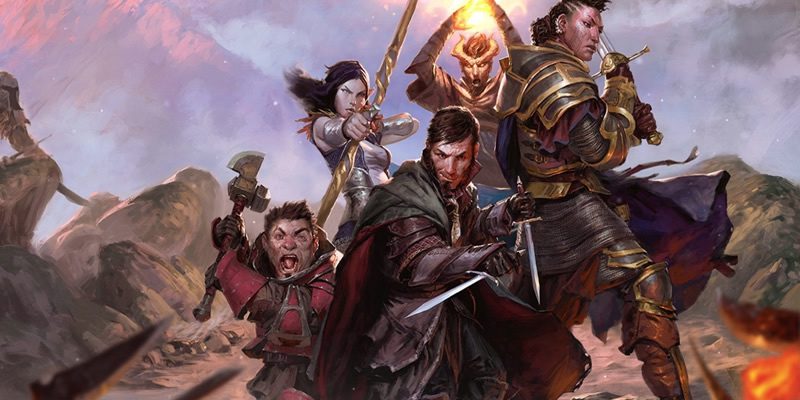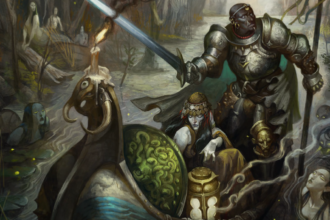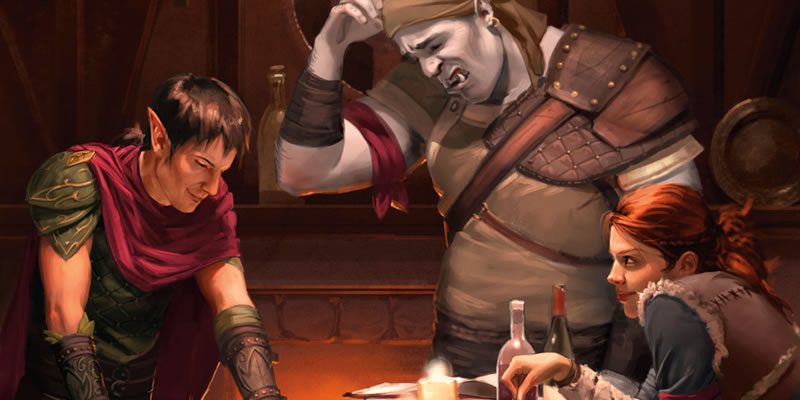UA 2020: Subclasses, Part Three Breakdown

It’s been a couple of weeks since the chaos of Subclasses, Part Two: Revenge of the Bride of the Electric Boogaloo, so yesterday WotC dropped three more playtest subclasses. We have the Armorer artificer, the Circle of Stars druid, and the Fey Wanderer ranger conclave. (Yes, I know it’s still technically “archetype,” because “conclave” got buried beside the UA Revised Ranger, but – and I cannot stress this strongly enough – you can have it when you pry it from my cold, undead hands.)
Part One | Part Two…B | Part Three
Armorer Artificer
I’ve written breakdowns for a hell of a lot of classes and subclasses at this point, but not very many of them have Marvel Comics in their crosshairs quite as specifically as this one does. There are plenty of articles on this very site on how to build Marvel characters in D&D 5e, but this? This is for Iron Man and Shuri and every other power-armor-jockey/engineer out there.
- Tools of the Trade grants – of course – smith’s tools, as well as heavy armor. Off to a good start.
- Armorer Spells tell a really interesting story of gear modification, rocketry, and force projection, though I do think hypnotic pattern is a bit of an odd fit there. I get it, but I might have scrounged for something else.
- There’s a great design note on how WotC designers approach spell selection for all of the different subclass features that expand your spell list. Very good read for anyone who wants to understand the logic of subclass spell assignment.
- Power Armor. First, let’s just admire the fact that the writers didn’t beat around the bush. It’s just straight-up power armor – based on modifying a suit of heavy armor you’re already wearing. MCU aesthetics married with the convenience of Eberron magic, hell yeah. Oh, right, it also does useful stuff!
- You circumvent the armor’s normal Strength requirement. Right, good, cutting back on severe multiple attribute dependency.
- The armor is a spellcasting focus for your spells. This is probably super important so you can keep using your hands for cool stuff in the next
- The power armor can’t be removed from you against your will, provides prostheses for any missing limbs (that is exceptionally boss), and covers your entire body. Presumably “covers your entire body” isn’t hiding any traps like preventing you from wearing magical boots or gauntlets.
- Ultimately this feature is cool but its feature are not heavy hitters in themselves. It’s providing a good foundation for the whole subclass’s function, though.
- Armor Model (still at 3rd – this is a smart 3-level multiclass pick, probably) gets into primary combat functions. You specialize your armor into one of two different paths, guardian or infiltrator. (Good job piquing my interest with those names, for sure.) Each has a special attack they get to make, and they can use Int to make that attack rather than Strength or Dex – again fending off multiple-attribute dependency. Guardian armor is… just shy of Hulkbuster armor, and Infiltrator armor is pretty much Black Panther’s vibranium armor. You can switch between guardian and infiltrator as part of a short rest.
- Guardian armor is, obviously enough, the tanking option. You can punch with your Thunder Gauntlets for 1d8 thunder damage, and your target has disadvantage to attack creatures other than you until the start of your next turn. They 4e-mark your target, sort of. You also get a defensive field, which lets you spend your bonus action to gain your artificer level in temporary hit points. Uh, whoa. Important for tanking with a d8 HD class, but still, that’s a lot.
- We also see here an experimental shift in wording: “You gain a bonus action that you can use…” Let me see if I can explain what’s going on here, because the Rules Tip sidebar covering this only helps so much. In theory, though definitely not in practice, you don’t have a bonus action that is going unspent on turns that you don’t use it. The feature that you’re spending the bonus action on also grants you the bonus action (but you can’t do this more than once on your turn). This is a bizarre semantic fiction that we’ve seen expounded upon in Twitter over the years, but the actual rules language of features, feats, spells, and so on has always gone with the much more direct “As a bonus action, you can…” type of wording. Here, WotC is trying to turn back the tide on that. Y’all. That ship has sailed, unless WotC’s plan is to make every 5e book published to date look like it’s in conflict with a new piece of the style guide?
- Infiltrator armor gains a Lightning Launcher, which is obviously ideal for “subtle undertakings.” It grants a d6 lightning ranged attack, and one attack per round with it that hits deals an extra 1d6 lighting damage. I mean, it was gonna be lightning or force, and they went with lightning. You also get a 5-foot speed boost from servos in your legs or whatever, and you can wear this heavy armor unobtrusively under clothing, without suffering disadvantage to Dexterity (Stealth) checks.
- Extra Attack at 5th – good fit for a very fighty artificer, sure.
- Armor Modifications at 9th level has the curious effect of splitting your power armor into four different “pieces” for purposes of your infusions. This feels like a strange feature to grant. Its benefit is good but winds up being predicated on a drawback that wasn’t well-explained at 3rd Also you can sustain two more infusions at a time, as long as both of the additional ones are part of your power armor. Now there’s a straightforward benefit.
- Perfected Armor at 15th level further improves the Guardian and Infiltrator options.
- Guardian gains a 30-foot, single-target tractor beam that you can use as a reaction, and if the creature ends within 5 feet of you, you also get to hit it. It’s a great defender stickiness power, but right at the edge of fitting into the fiction of the rest of the Guardian suit.
- Infiltrator’s lightning attack leaves a glow of lightning behind that grants advantage to the next creature to attack that target, and if that attack hits, it deals an extra 1d6 damage. Looks like a good support-through-ranged-attack feature to me.
I don’t think I’ve hidden the fact that I think this is a super cool subclass, and I expect it to be an instant hit among artificer builds. My two little issues with it are the thing I mentioned about Armor Modifications, and that I want the door to stay open for a third and fourth armor mode. At minimum I want to see a flyer (outside of the winged boots infusion, I mean) and a melee striker/skirmisher (completing the Black Panther/Warframe concept). Regardless, there’s a lot to love in this subclass. It’s always great to see subclasses that bridge a class into a combat role that isn’t its default mode.
I also respect that these artificers could just be Mandalorians in a world where Beskar steel isn’t that damn hard to find. Whistling birds and disintegration rifles absolutely sound like some great high-level artificer tricks.

New Artificer Infusions
Also, there are five new infusions!
Armor of Magical Strength furthers the idea of using your Int (artificing potency) in place of Strength for checks and saves – very appropriate to Iron Man or Shuri. The armor also has 4 charges that you can use to ignore effects that would knock you down. A must-have if Guardian mode is a key part of your party role.
Armor of Tools is your Go-Go-Gadget arcane-screwdriver or whatever. You can store a tool in your armor (let’s face it, the answer should just about always be thieves’ tools, just in case), and you can use Int in place of any other ability for checks with that tool.
Helm of Awareness gives advantage on initiative checks, and makes you immune to surprise as long as you’re not incapacitated. Seems fine. Go ahead and name it JARVIS.
Mind Sharpener is described a little oddly – sending a “jolt to the wearer to refocus their mind.” That sounds like the opposite of sustaining concentration to me, but that’s what this does as long as you have a reaction to spend. That’s absolutely incredible (there’s no use limit other than costing a reaction, and it always restores concentration when you use it), but you definitely can still lose concentration if you’re getting hit multiple times in a round.
Spell-Refueling Ring lets you refresh one spell slot per long rest, with a spell level up to the number of magic items you have attuned. That sounds pretty good at any level of play, but with a strong potential for power creep (as I’m sure someone will write some circuitous way for artificers to equip a seventh, eighth, or ninth magic item).
Circle of the Stars Druid
Druids who watch the stars and have some kind of reason to care about megaliths? Yes please. Also a divination/fate-control thing? Even better! This subclass story couldn’t fit into my homebrew setting any better if I had designed it myself, so I’m instantly intrigued.
- Starry Map gives you a cool prop (the map, in whatever form – all of the suggestions are great) gives you a number of free castings of augury and guiding bolt, in any combination, up to your Wisdom modifier per long rest. That’s a particularly significant power boost at low levels.
- Starry Form gives you an alternate application for your Wild Shapes: you look something like a constellation, with stars marking your joints and connected by lines. This lasts 10 minutes or until you are incapacitated. When you use it, you pick one of three different constellations.
- The Chalice splashes you or another target of your choice with healing when you restore hit points with a spell slot. That splash of healing is good enough to double a 1st-level cure wounds, so this is a great healing option.
- The Archer lets you fire luminous arrows (ranged spell attacks) as a bonus action, dealing 1d8 + Wisdom modifier radiant damage on a hit. This is a great damage kicker for druids otherwise spending their rounds on moonbeam or call lightning or whatever. I’m choosing to see this as a tiny bit of WoW boomkin love.
- (Here again we see the tortured “gain a bonus action” wording.)
- The Dragon gives you a floor of 10 on Int and Wisdom checks, and on Con saves to maintain concentration. That’s incredibly good – you’re probably well into the late game before you regularly need those Con saves to hit DCs higher than 10.
- Cosmic Omen at 6th level is sort of paralleling the incredible Portent feature of the Diviner wizard, but you’re 50% likely to foretell ill fortune to your enemies and 50% likely to foretell good fortune to your allies. You start with a d6 roll at the end of a long rest, where all that matters are odds or evens.
- Odds, you can use your reaction to subtract 1d6 from a d20 roll by a creature within 30 feet that you can see.
- Evens, you can use your reaction to add 1d6 to a d20 roll by a creature within 30 feet that you can see.
- You gain Wis modifier uses per long rest of this. What isn’t clear is exactly where in the timing the trigger for this reaction occurs. Specifically – do you get to see the d20 result before you decide whether or not to use this? For more on the nuances or reaction timing, check out this Tribality article.
- Full of Stars at 10th level grants resistance to bludgeoning, piercing, and slashing damage, because you’re partially incorporeal. I mean, even if you have no business being in melee weapon range of anyone, this is still a huge survivability boost.
- Star Flare at 14th level is a visually cool and useful feature that slips a bit on clear connection to the rest of the subclass narrative. In part, it’s confusing because it’s defining two different 30-foot radii (uh, maybe? There are two possible antecedents for “it” in the seventh line.) and a 120-foot range. Once per long rest, or refresh it by burning a 5th-level slot. Still a huge fan of spell slots to reset 1/long rest features.
- Basically, you drop a big burst of starlight, teleport your friends, and blow up your enemies. What if moonbeam but also mass misty step, I guess? And that’s probably a lot of fun to use, but it’s not the astrologer-druid we’ve been following up to this point.
I’m still super invested in this subclass’s aesthetic and gameplay, but I might like to see a different 14th-level feature. It’s not bad, just tonally odd. The Starry Form options are incredible, and I’d like to see that list extended a bit more (because I always feel that way about cool lists of options). Hands down, the best thing about this subclass is how strong its visuals are.
Fey Wanderer Ranger Conclave
On the basis of name alone, this is another subclass I’m positively inclined toward. Some of the implication here is like a Horizon Walker that only cares about one planar border. You also might have a quasi-patron among the fey, or just a bond with a fey location.
- The Feywild Gifts table generates a cosmetic effect that represents your connection to the fey or the Feywild. There’s a strongly Seelie vibe from most of these.
- Fey Wanderer Magic gives you five more Spells Known, mostly spells we’ve seen a lot of other fey subclasses lean on. Banishment is the surprise here, to me – but it’s perfect for a border warden concept.
- Cunning Will grants advantage on saving throws against the charmed and frightened conditions, and proficiency in one of Deception, Performance, or Persuasion. Nice to have, though I don’t know that I’ve seen a ranger who had a decent score to spare for Charisma (but see below).
- Dreadful Strikes lets you imbue your attacks with Unseelie magic. (I grudgingly accept that WotC doesn’t capitalize “unseelie,” but my breakdown is not bound to their style guide.) Anyway, it makes your attack magical and adds 1d6 psychic damage per hit (for one or multiple weapons), though a single creature can take that damage only once per turn – so spread your attacks around. The magic ends at the end of your turn, so there’s no help for opportunity attacks or other reaction attacks here.
- There’s a clause that offers special handling for two-weapon fighting, since this costs a bonus action. It’s pretty clear from the first paragraph (“imbue the weapon, or weapons, you’re currently holding”) that the text wants you to get this bonus on both of your weapons, then make your whole series of attacks including your off-hand attacks. The problem is in the formal timing of Two-Weapon Fighting. “When you take the Attack action” is a trigger that permits the use of the bonus action for the off-hand attack, and the bonus action therefore has to come after the event that triggered it. (Compare this to the whole question of bonus action timing for the Shield Master feat.) This means that at best you can interrupt your Attack action (because you have Extra Attack) with your bonus action, and you get this benefit on two of your three attacks in the round.
- EDIT: As is pointed out in the comments, any use of bonus actions is going to be fraught for a ranger, and this has the effect of significantly pushing the ranger away from using hunter’s mark.
- Blessings of the Courts at 7th level gives you a pseudo-Divine Smite – once per turn, you can dump a spell slot into your weapon attacks after they hit, adding 3d6 psychic damage and forcing a Wis save, frightening targets that fail. Also, you can add your Wis bonus to your Charisma checks, which is a huge deal for making Cunning Will more useful.
- It’s super weird to have no scaling function from spending higher-level spell slots. I get that Divine Smite is one of the strongest burst-damage features in all of 5e – I got a refresher course in how crazy it can get this past weekend! – but I feel confident that the absence of a scaling function will feel bad once you’ve exhausted your 1st-level slots. The once-per-turn constraint is also a major control on burst damage.
- Having said all of that, this is still a great feature.
- Beguiling Twist at 11th level lets you grab mind-affecting magic that fails to affect your allies, and retarget it onto your enemies, potentially charming them, frightening them, or hitting them with a bunch of psychic damage. It’s a very flashy reaction that comes up constantly in some encounters and not at all in some whole adventures. The 120-foot range on this is something of a surprise, but it’s a big help for bow rangers that the feature doesn’t assume they’ll be right in the thick of combat.
- EDIT: As a few readers have pointed out, the mind-affecting magic can be targeting anyone in range, including an enemy, as long as they succeed their save. Blessings of the Courts and the charm person you get from Fey Wanderer Magic can both trigger this – you just have to make your new target someone other than the initial target of the effect. I love the reliability here.
- Misty Presence at 15th level is an unusual long-term effect that makes you invisible to one creature. The target gets a saving throw, and a new saving throw each time you hit it, force it to make a saving throw, or deal damage to it. Once they succeed this save, they’re immune for a week. This takes a bonus action, you can use it once per long rest, and you can refresh that use by burning a 4th-level slot. You can explicitly only sustain this against one character at a time.
- That’s a super cool fey-themed feature, though if anything I’d expect the reverse – visible only to one character.
I like most of what goes on here, though having a ranger lean this heavily on psychic damage is a weird fit. Beguiling Twist seems like a weird fit to me, and I kinda wish they had given this to Enchanter wizards instead (because it shows mastery of mind-affecting magic while doing something other than the charmed condition again). As you know if you’ve read my ranger subclasses, I am all about giving rangers a Divine-Smite-like way to spend spell slots, all the more because ranger spells are so disappointing.
Conclusion
The subclasses here bring a lot of intensity right out the gate, and I would be happy to play any of them. Their concepts are striking and immediately clear. Honestly, I don’t know how you could read the Armorer and not instantly want to play it. (I don’t need to know.)
I wish there were a few more exploration or social-interaction features getting tossed out in this document – they’re not absent but I think they could be stronger. That’s something I generally want out of 5e at this point, though.
The bonus action wording bugs me. It’s based on a polite fiction denying that the bonus action is a default part of your turn, because players who didn’t have a way to spend their minor actions in 4e felt like they were missing out somehow. That was a sort of odd idea in 4e, but it’s much less of a danger in 5e, because classes and subclasses do engage deeply with bonus actions as part of their gameplay. I think that’s been an unsung part of 5e’s popularity – it feels good to make two different action choices (action and bonus action, I mean) on your turn.



